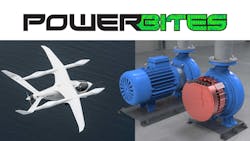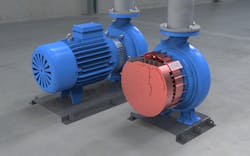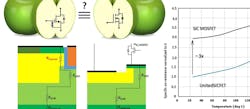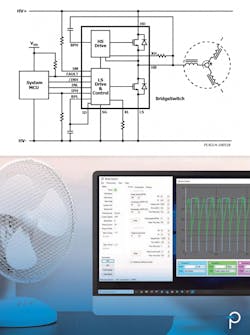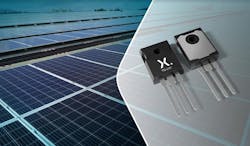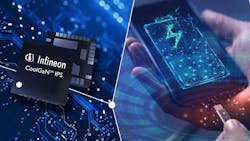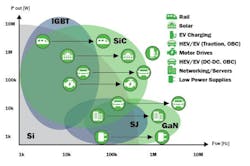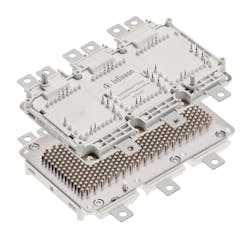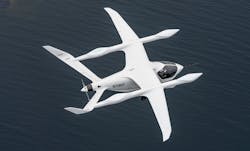This Week in PowerBites: Motors with Printed Stators, USAF Approves eVTOL
This article is part of the Power Management Series: This Week in PowerBites
Climate-Friendly, Market-Ready Cooling Technologies Emerge from Global Competition
Winners of the Global Cooling Prize were recently honored for their cooling advances, creating products and technologies that deliver cooling with over 5X lower climate impact. It’s also expected that their reduced operating costs are expected to encourage their adoption in both developed and emerging economies.
The competition was initiated by a global coalition of the Government of India, Mission Innovation, and the Rocky Mountain Institute (RMI). It encourages the development of breakthrough technologies that dramatically reduce the energy consumed by air-conditioning systems, which currently consume at least 10% of the world's electricity supply—a number that’s expected to increase as the climate warms.
Gree Electric Appliances Inc. of Zhuhai with partner Tsinghua University, and Daikin with partner Nikken Sekkei Ltd., emerged as the two winners among eight finalists after shattering the perceived ceiling of performance. These companies have produced prototypes with 5X less climate impact than standard air-conditioning units available in the market today. When scaled, such technologies can prevent 132 GT of CO2 -equivalent emissions cumulatively between now and 2050, and mitigate over 0.5°C of global warming by the end of the century.
The prize finalists, which collectively produce well over 20% of the world’s residential room ACs, are determined to bring them to market by 2025, or earlier. Additional details of the Global Cooling Prize program can be found in a highly readable article recently posted in SEO Small Business.
Smart, Ultra-Efficient Industrial Motors Use Printed Stators
Infinitum Electric expanded the range of power and frame sizes for its IEs Series of motors, now available with outputs from 5 to 15 horsepower, for fans, pumps, compressors, conveyors, and general-purpose applications. The motors feature an air core architecture and a unique printed stator that requires much less copper and virtually eliminates the core losses associated with conventional motors. In addition to being extremely efficient, Infinitum's architecture is simpler to manufacture and is 50% lighter and smaller than a similarly rated NEMA Premium motor.
The motor's high efficiency and compact size are the result of a new architecture that replaces conventional motors' rudimentary iron core and copper wire with a copper-etched PCB. The motor's reduced core losses and fully integrated variable-frequency drive (VFD) make it among the industry's most efficient, while its low-torque ripple makes it the quietest motor system on the market, according to Infinitum.
IEs Series motors are fully integrated systems consisting of the motor, a VFD, and embedded IoT combined in a single compact form factor. Their embedded self-monitoring and IoT capabilities make them ideal for smart-building/smart-factory/smart-city applications that require remote monitoring, control, and predictive maintenance.
Infinitum was founded with a focus on high efficiency—the intent is to create cost-effective products that allow their customers to build products offering lower operating costs and lower carbon footprints. Customers currently using Infinitum Electric’s debut model, the IEs205, include Comefri USA, Twin City Fan & Blower, and ACME Fan.
“Infinitum Electric’s expanded product line, compact form factor, and ability to manufacture in North America allow us to rapidly deliver innovative, efficient HVAC systems to our customers who also benefit from easier installation and noise reduction,” said Doug Yamashita, EVP of sales and marketing at ACME Fan.
Navigating the WBG Wilderness: Making Sense of MOSFET On-Resistance
Wide-bandgap (WBG) power devices are still in their infancy, and making meaningful comparisons between the products and technologies on the market can be difficult. However, an article we recently published may help shed a little light on the subject.
Authored by Anup Bhalla of UnitedSiC, "Making Sense of MOSFET On-Resistance Comparisons" offers a clear explanation of the impact of on-resistance on MOSFETs and the role of temperature coefficient in comparing different MOSFETs' on-resistance. Although it does include the obligatory sales pitch for UnitedSiC's products and technologies, the insights it provides are valuable for working with whatever WBG device you eventually choose. Click here to read the article.
Software Enables Precise Control and Tuning of Single-Phase BLDC Motor Drives
Power Integrations has released its Motor-Expert software, an embedded “C” code application, library, and control GUI that enables designers using the company’s BridgeSwitch brushless dc (BLDC) motor-driver ICs to precisely control and tune single-phase motors. The software supports the cost-effective single-phase motor architecture that can be used to replace more expensive three-phase motor systems in many modern, high-efficiency appliances. These include compressors, fans, and water pumps in domestic appliances, and ceiling fans and room air-conditioning systems.
The Motor-Expert software platform comes with reference designs and ready-to-use application examples for constant-speed and constant-torque operation, all of which are IEC6730 Class A-ready. It supports both sensor and sensorless operation, providing developers with additional system cost-reduction options, and it’s transportable to many commonly embedded microcontrollers.
Motor tuning is performed through Motor-Expert's user interface, which allows for updating of new control-loop coefficients in real-time without having to recompile code. The interface also enables users to visualize system operation, displaying the status of data including current, speed, status, current error, and speed error. A diagnostics field within the software interface provides insight into inverter and motor operation.
The Motor-Expert software features accurate speed and current control-loop functions. Thanks to the modularity and flexibility of the API-based software architecture, new use cases and functions can be added. Furthermore, users are able to port the software to their favorite microcontroller or combine with other code in a system CPU. The software meets static (MISRA) and dynamic performance profiling covering latency, jitter, and execution time.
The platform requires only 14-kB code memory and 5-kB SRAM, suiting it to microcontrollers with small memory capabilities. The BridgeSwitch motor-drive IC can pair with 3- and 5-V MCUs and removes the need for an external shunt resistor.
The BridgeSwitch integrated half-bridge IC family dramatically simplifies the development and production of high-voltage, inverter-driven, single- or multi-phase permanent-magnet (PM) and BLDC motor drives. Its superior efficiency and distributed thermal footprint eliminates the need for a heatsink, reducing system cost and weight. Built-in hardware motor overcurrent protection enhances safety and reliability, and simplifies IEC 60335-01 and IEC 60730-01 certification, significantly shrinking time-to-market.
The Motor-Expert GUI operation, software manual, and hardware documentation for the BridgeSwitch BLDC motor-drive family of ICs is available at https://motor-driver.power.com/bridgeswitch.
650-V GaN FETs Designed for 80 PLUS Titanium-Class Power Supplies
Available in TO-247 packaging, the new 650-V H2 power GaN FETs are fabricated using an advanced process that reduces their die size for a given RDS(on) value by 36%, improving stability and efficiency. As with the 1st-gen products, their cascode configuration eliminates the need for complicated drivers while delivering outstanding performance in both hard-switching and soft-switching configurations, thus maximizing flexibility.
Dilder Chowdhury, Nexperia’s GaN Strategic Marketing Director explains, “Titanium is the most demanding of the 80 PLUS specifications, requiring >91 % efficiency under full load conditions (>96% at 50% load). Achieving this level of performance in server power applications operating at 2 kW and above, using conventional silicon components, is complex and challenging. Nexperia’s new power GaN FETs are ideally suited to an elegant, bridgeless totem-pole configuration that uses fewer components and reduces both physical size and costs.”
The Nexperia GAN041-650WSB GaN FETs are now available in high volume. For more information, including product datasheets and quick learning videos, visit https://www.nexperia.com/products/gan-fets.html.
Integrated Power-Stage Devices Target Consumer Apps from 30 to 500 W
A new series of half-bridge and single-channel products from Infineon Technologies targets low- to medium-power applications, including chargers and adapters and SMPS.
The 600-V CoolGaN half-bridge IPS IGI60F1414A1L, well-suited for compact and lightweight designs thanks to its thermally enhanced 8x8 QFN-28 package, enables systems with very high power density. The product combines two 140-mΩ/600-V CoolGaN e-mode HEMT switches with dedicated, galvanically isolated, high- and low-side gate drivers out of the company’s EiceDRIVER family.
The IGI60F1414A1L is easy to control due to the isolated gate driver with two digital pulse-width-modulated (PWM) inputs. The integrated isolation function, the clean separation of digital and power ground, and the reduced complexity of the PCB layout help shorten development time as well as reduce system bill of materials (BOM) and total cost. The gate driver’s input-to-output isolation uses an on-chip coreless transformer that can even work with extremely fast switching transients exhibiting voltage slopes exceeding 150 V/ns.
The switching behavior of IGI60F1414A1L can be easily adapted to the needs of different applications using a small number of few passive components. This allows for slew-rate optimization to, for example, reduce electromagnetic-interference (EMI) efforts, steady-state gate current setting, and negative gate drive for robust operation in hard-switched applications. As a result, the IGI60F1414A1L can be fine-tuned to produce the lowest possible system dead-times for maximum system efficiency.
The IGI60F1414A1L comes in a thermally enhanced 8x8 QFN-28 package and can be ordered now. More information is available at www.infineon.com/coolgan-ips.
Open-Source Power-Delivery Software Facilitates USB System Differentiation
The new Power Delivery Software Framework (PSF) developed by Microchip Technology enables designers to easily modify and own the IP in their USB-C Power Delivery (PD) systems. By merging their proprietary code with Microchip’s fully functional PD stack, designers can easily create differentiated product offerings from a wide variety of Microchip SmartHubs, microcontrollers (MCUs), and standalone PD solutions for their USB systems.
The PSF solution offers both an open-source code base for power delivery and a comprehensive programming environment, allowing for manufacturer-independent code development. Users can now program MCUs and immediately modify PD code as their system evolves. Due to the PD architecture’s open approach, customers are able to easily add a USB-C/PD port to a wide range of embedded applications as well as reallocate unused pins or CPU memory to other system functions.
A range of Microchip SAM and PIC MCUs and dsPIC digital signal controllers (DSCs) are supported. The PSF solution gives designers the option to run PD on an existing Microchip MCU infrastructure by adding the UPD350 PD transceiver or integrating PD into more complex product offerings with proprietary system code.
By leveraging Microchip's open software and hardware frameworks, developers can also choose from an expanded family of Microchip controller options to host PD functionality, including the new UPD301B and UPD301C standalone PD controllers.
The PSF software solution is supported by Microchip’s MPLAB X IDE development environment. In addition, the PSF evaluation board features the SAMD20 MCU and the UPD350 PD PHY and is available today.
Pricing and Availability
Microchip’s open-source Power Delivery Software framework (PSF) is available for download on Microchip’s website at no cost. The UPD301C is available for $1.50 in 10,000-unit quantities.
New Generations of SUPERFET MOSFETs and SiC Diodes Announced at PCIM Europe 2021
ON Semiconductor unveiled its new series of superjunction (SJ) MOSFETs and SiC diodes during the PCIM Europe 2021 Digital Event. Designed to make it easier for manufacturers to meet more stringent international efficiency standards, the 650 V SUPERFET III FAST SJ MOSFETs deliver better switching performance than competing superjunction MOSFETs, claims the company, along with improved efficiency and higher system reliability. Such features are in high demand for many applications, including 5G, electric-vehicle (EV) charging stations, as well as telecom systems and server farms.
Next-generation automotive AECQ101- and industrial-grade-rated 1200-V SiC diodes also were introduced by ON Semiconductor. They offer higher reliability, lower EMI, and simpler cooling requirements for high-power applications like EV charging stations and solar inverters, UPS, EV on-board chargers (OBCs), and EV dc-dc converters.
The new SiC diodes’ improved performance comes from their lower capacitance, made possible by a smaller die size. The NVDSH20120C, NDSH20120C, NVDSH50120C, and NDSH50120C have a lower forward-voltage drop and a 4X increase in rated current, with a higher rate of change (di/dt) of 3500 A/µs. The smaller die size also produces 20 % lower thermal resistance in an F2 package.
Click here to learn more about the SuperFET III series of fast SJ MOSFETS, and click here to learn more about ON's next-generation SiC diodes.
Additional resources on WBG devices:
- Demystifying Three-Phase PFC Topologies
- Developing A 25-kW SiC-Based Fast DC Charger
- Why Solar Power Needs Silicon Carbide
- Silicon Carbide’s Role in Next Generation Industrial Motor Drives
- How Silicon Carbide Technology Changes Automotive On Board Charging
Compact, Rugged Gate Driver Built for IGBT Modules in Railways, Other Heavy Equipment
Power Integrations’ new SCALE-2 gate driver targets 130- × 140-mm single IGBT high-power (IHM) modules commonly used in railway and other long-life applications, such as large commercial, construction, and agricultural vehicles (CAVs). Comprising the 1SP0630V2M1R main driver, 1SP0635D2S1R peripheral driver, and ISO6125R-33 power supply, the SCALE-2 plug-and-play gate drivers streamline system development and installation. These gate drivers are particularly beneficial in systems requiring parallel modules for additional power, providing simplicity and flexibility in both electrical and mechanical design.
The compact SCALE-2 gate drivers match the footprint of the smaller IHM single-channel IGBT-module formats with output current of 1200 to 1400 A and 3300-V IGBT blocking voltage. All SCALE-2 products are based on an ASIC chipset that reduces component count and size while providing increased performance, scalability, and reliability. This enables designers to optimize dynamic switching performance, accuracy, and functionality as well as include advanced active clamping circuitry to protect the IGBT.
The 1SP063xxxx1R gate drivers meet IEC 61373 specifications for shock and vibration and IEC 60068-2-xx environmental requirements. Units are also EMC-qualified according to EN 50121-3-2 and IEC 6100-4-x. With standard conformal coating, the new gate drivers can also undergo burn-in on request for added reliability. Improved connectors increase interconnection security and facilitate fast release without tooling. Fiber-optic interfaces are provided.
Protection features for the 1SP063xxxx1R gate drivers include dynamic advanced active clamping, short-circuit, and undervoltage lock-out. Failure status output also is provided. For more information on the new rail gate driver, which are available now, visit www.power.com/products/scale-2-plug-and-play-drivers.
Upgraded Ceramic MOSFET Modules Offer High Power Density, Superior Cooling
Infineon Technologies announced several additions to its family of rugged ceramic power modules based on the company’s CoolSiC MOSFET technology. The new introductions feature packaging that uses a new aluminum-nitride (AIN) ceramic to deliver enhanced thermal properties that allows for higher power densities and reliability. With the improved thermal conductivity of the direct-copper-bonding (DCB) material, the thermal resistance to the heatsink (RthJH) can be lowered by up to 40%.
Cooler-Running Half-Bridges
Infineon's upgraded FF11MR12W1M1_B70 and FF6MR12W2M1_B70CoolSiC modules come in half-bridge configuration with an on-state resistance (RDS(on)) of 11 mΩ in an EasyDUAL 1B package and 6 mΩ in an EasyDUAL 2B package. Armed with the high-performance AIN ceramic package, the 1200-V devices are suitable for high-power-density applications including solar systems, uninterruptible power supplies, auxiliary inverters, energy-storage systems, and EV chargers.
Availability
The FF11MR12W1M1_B70 and FF6MR12W2M1_B70 EasyDUAL CoolSiC MOSFET modules are available now. For additional information on the family of EASY modules, go to www.infineon.com/easy.
Industry’s first automotive-qualified SiC six-pack power module for EV traction inverters
Infineon Technologies new HybridPACK Drive CoolSiC is an automotive power module that integrates a full-bridge module with 1200-V blocking voltage that’s been optimized for traction inverters in electric vehicles. It’s based on the automotive CoolSiC trench MOSFET technology and offers higher efficiency in inverters with longer ranges and lower battery costs, particularly for vehicles with 800-V battery systems and larger battery capacity.
The HybridPACK Drive is specifically optimized to deliver the best efficiency on a real-world driving cycle and has a scalable power range of 100 to 180 kW within the 750-V class and up to 250 kW in the 1200-V class. To offer an optimal cost-performance ratio for different power levels, this product comes in two versions with different chip counts, resulting in either a 400- or 200-A dc rating version in the 1200-V class.
Availability
The new HybridPACK Drive CoolSiC is in production now and will be available starting June 2021. More information is available at www.infineon.com/sicatv.
1500-V MOSFET module for solar-power and energy-storage systems
The F3L11MR12W2M1_B74 power module is the latest addition to the company’s 1200-V family, featuring a three-level Active NPC (ANPC) topology and designed to handle fast-switching dc-link voltages of up to 1500 V in solar-power-system and energy-storage-system (ESS) applications. It’s housed in a thermally enhanced EasyPACK 2B module that integrates CoolSiC MOSFETs, TRENCHSTOP IGBT7 devices, and an NTC temperature sensor along with PressFIT contact technology pins.
The power module is designed to operate across the entire power-factor (cos φ) range. A single module per phase can supply a power level of up to 75 kW in energy-storage applications. For solar applications, a power level of up to 150 kW can be reached by operating two modules in parallel per phase.
The device is suitable for fast-switching applications like ESS. Its advanced design offers excellent thermal properties that provide enhanced cooling as well as improved pin positioning for clean commutation loops that reduce stray inductance. As a result, the EasyPACK 2B module increases the power rating and efficiency of solar systems and supports the growing demand for 1500-V dc-link solar applications.
Availability
The F3L11MR12W2M1_B74 EasyPACK CoolSiC 1500-V MOSFET module is available now. For specifications and pricing, click here. Additional information on the EasyPACK product family is available at www.infineon.com/easy.
Hybrid eVTOL is First Crewed Electric Aircraft to Earn USAF Airworthiness Approval
BETA Technologies' Electric Vertical Aircraft, known as ALIA, has begun flying under an Air Force operational flight test program after receiving first airworthiness approval for a crewed electric aircraft by the U.S. Air Force's Agility Prime Program. The program was created to accelerate development of the commercial eVTOL industry. Although BETA is the second company to receive a Military Flight Release (MFR) from the Air Force’s Agility Prime program, its competitor, Joby, which received its approval late last year, is currently only certificated for un-crewed operation.
The dual-mode aircraft can take off using its stowable lift rotors, and then convert to more efficient fixed-wing flight mode that allows it to carry six people or 1400 lbs of cargo over 250 miles at speeds of up to 170 mph. Following an early series of tethered hover tests, Beta has been flying ALIA with its overhead lifting propellers removed while it explores the aircraft’s fixed-wing handling characteristics.
In addition to field and real-life applications in the aircraft flight test program, BETA’s flight simulation and training facilities allow Air Force pilots and engineers to experience the future of EVA by rehearsing and testing the ALIA aircraft in a variety of potential mission sets and scenarios.
During their partnership, the Air Force's advanced urban air mobility technology simulator, located near the USAF Research Laboratory (AFRL) in Springfield, Ohio, and the Washington D.C. test facility also will be used to help the Air Force’s technical acquisition workforce, assisting senior leaders and decision makers in evaluating the aircraft. These state-of-the-art, physics-based simulators can put ALIA through its paces under a wide range of challenging conditions that include weather, emergency handling, battle damage, and advanced mission scenario simulation.
BETA is also gaining traction in the commercial market thanks to a recently announced deal with UPS to begin delivery of 10 ALIA-derived aircraft in 2024, with an option for up to 150 more. The company recently inked another deal with Blade, an air mobility service startup, to purchase up to 20 Alia aircraft for cargo and urban air mobility missions.
This article is part of the Power Management Series: This Week in PowerBites
